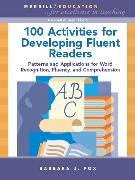100 Activities for Developing Fluent Readers
BücherAngebote / Angebote:
100 Activities for Developing Fluent Readers will help you through the important decisions of what, why, when and how to teach all children as they develop their reading and writing skills in grades K-6. This text serves as a resource for the busy teacher by minimizing time spent searching for research-based activities that represent best practice. This text is designed for teachers in their efforts to help every child reach his or her full potential and become confident readers, instilled with a love of reading. You will find that this text: presents more than a list of activities--simple explanations in this text show how each chapter's activities propel students toward literacy development. provides chapter-specific information highlighting specific reading components and their roles in proficient reading. It then identifies a view of each component in the classroom environment, numerous teaching activities, informal assessment strategies, and a chart with best teaching practices. is organized to maximize utility: the activities offer grouping options, a materials list, step-by-step directions, and options for differentiating individual student needs--including English language learners and children at risk. One of the main reasons that I used Fox's text was because activities are grounded within the necessary literacy theory for preservice teachers and teachers to make professional decisions regarding their students' literacy learning. Dr. Merry Boggs, Tarleton State University (referring to ch. 8): These are excellent, clear-cut examples of what to do. So often, teachers are not well-schooled in these methods. Characteristics of each stage help teachers to observe informally and adjust their instruction. [Chapter 5] is a real gem...Structural analysis can be a complex and dry subject to teach...The author presents a lot of info in a systematic format and supports each area of the concept with tables and clear examples. I will use this in my own practice. Dr. Jane F. Rudden, Millersville University of Pennsylvania The author begins the chapter [7] very well with the description of the four levels of fluency and guidelines for developing reading fluency. I believe that this is a great way of bringing all the information in this text together. It provides the reader with an understanding of why we teach and model these skills and strategies in an elementary classroom. Dr. Ann A. Wolf, Gonzaga University
